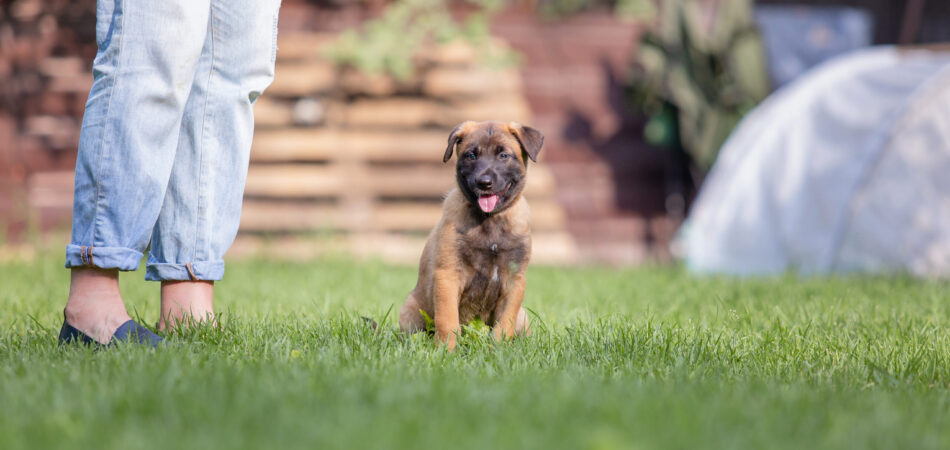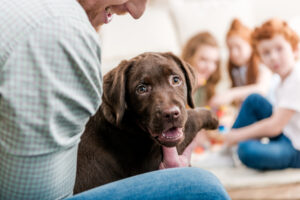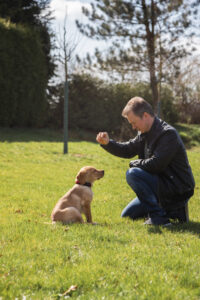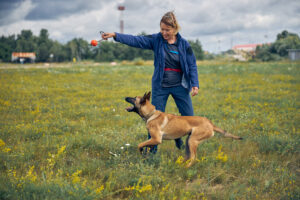






When you see elite protection dogs in action, it’s easy to be in awe of their intense focus, lightning-fast reflexes, and unyielding loyalty to their handler. These highly-trained protection dogs demonstrate a remarkable ability to protect and respond to potential threats while maintaining control.
But the journey to transform a playful puppy into a disciplined, elite protector is neither quick nor easy. It requires immense dedication, patience, and specialized protection dog training from an experienced dog trainer.
To get an insider’s look at how these remarkable dogs are raised and trained, I shadowed Vit Singh, a renowned dog trainer with over two decades of experience leading the K-9 Unit at Vanguard Protection Dogs.
It became clear that the foundation for trained protection dogs is laid long before the formal protection training even begins.
“It all starts with selecting the right puppy,” Vit explained. “We seek high-energy, confident dogs with a pronounced prey drive—the innate instinct to chase and capture moving objects.
Breeds like German Shepherds, Malinois, and even Rottweilers often stand out for their potential to become exceptional protectors.”
To ensure the highest standards, the department establishes close relationships with reputable breeders.
This collaboration is crucial, as finding puppies with the right combination of temperament and unique personalities requires expertise and trust.
And to be on the safe side, Vit personally travels to Europe to assess each puppy before making a purchase.
“We often evaluate fifty dogs to find just one that meets our exacting criteria,” he shared. “We have a strict standard. If a dog can’t cut it, we won’t buy it, and we certainly won’t sell it to you.”
Some qualities, like a dog’s temperament and ability to become a confident protector, are innate and cannot be taught.
It’s a process that takes a skilled trainer, a clear understanding of canine behavior, and a dedicated team to identify the next elite protection dog.

“From a very young age, we start exposing the puppy to a wide variety of stimuli—different people, sounds, surfaces, and environments,” said Vit.
“This early socialization is crucial for developing a confident, well-adjusted dog that isn’t scared or reactive in new situations.”
By maintaining a calm environment during these training sessions, the puppy learns to adapt and grow into a well-rounded and balanced dog.
Now, here’s where it gets interesting. Training elite protection dogs isn’t just about teaching commands – it’s about shaping a mindset.
“From day one, we’re cultivating a balance between obedience and initiative,” Vit explained. “We want a dog that will follow orders to the letter but also think on their feet when the situation calls for it.”
This process incorporates rigorous protection dog training, including specialized techniques like bite work to prepare the dog for real-world scenarios.
It’s a delicate process, and it takes years to perfect.
Let’s break down the journey:
The initial phase focuses on the fundamentals—sit, stay, come—the ABCs of dog training.
However, this stage is more than teaching mere commands. “We’re establishing a communication system between handler and dog,” Vit clarified.
These commands form the initial vocabulary in a language developed between humans and canines. Through consistent training sessions, trainers help dogs interpret the handler’s cues and expectations, fostering mutual respect and trust.
And trainers don’t forget to reward the dogs.
Every positive reinforcement, whether verbal praise, a physical pat, or a tasty treat, strengthens the bond between the handler and the dog, building a strong bond that is essential for future protection work.
Beyond obedience…
…these commands cultivate focus and attention. A dog that reliably responds to “sit” or “stay” demonstrates a high level of concentration on its handler.
This attentiveness, developed through dog training and regular sessions, is crucial for the training process and for building a strong bond that ensures success in future protection work.

But can the dog maintain obedience and control in noisy environments, surrounded by hundreds of people, other animals, or even gunfire?
“This is where the rubber meets the road,” Vit stated. Advanced obedience is the measure that separates exceptional dogs from simply good ones.
We’re talking about off-leash control, precise distance work, and maintaining focus amidst several distractions.
This stage challenges the dog’s ability to remain a true guardian in high-pressure situations while demonstrating controlled behavior.
The transition from basic obedience to advanced protection dog training is like leaping from elementary school to a Ph.D. program.
This phase is about refining raw talent, testing limits, and building resilience. Dogs are trained to assess perceived threats and respond appropriately, using their defensive drive when necessary.
The foundational obedience commands—sit, stay, come – are now executed with split-second precision, even in the most demanding environments.
“We introduce complex commands and scenarios,” Vit explained, “testing the dog’s ability to think independently while maintaining focus on the handler.”
It’s a period of intense mental and physical stimulation, pushing the dog to its limits and revealing its true potential.
Now we’re in the big leagues.
At this stage, the dog matures into its role. It’s about honing in on specific talents and refining instincts, whether it’s the adrenaline-fueled personal protection dog, the meticulous precision of detection work or the compassionate role of a service dog.
Training becomes increasingly specialized, with scenarios mirroring real-world challenges.
For personal protection dogs, training might include perimeter searches, home defense, anti-kidnapping drills, multiple attacker scenarios, and ATM protection.
Executive protection dogs may require additional training in aircraft, helicopter, and watercraft operations, large estate security, multiple handler protocols, and bomb detection.
It’s a period of refinement, where every interaction is an opportunity to build upon the existing skill set.
The dog learns to think critically, anticipate threats, and work independently while maintaining a strong bond with the handler.
Training becomes increasingly tailored to the dog’s breed and personality. Each dog’s unique personality and abilities determine its specialized role.
Challenging? Absolutely.
Rewarding? You bet.
Throughout the training process, the handler and dog develop an incredibly strong bond.

This personal protection training partnership is critical because once a dog graduates the program, it’s paired with a specific handler or owner who it will work with exclusively.
“The bond between owner and dog is unbreakable. They rely on each other completely in high-stress, dangerous situations, where handler protection and safety are paramount.”
And the stakes couldn’t be higher. These dogs are not only protecting their human partners but also assessing every potential threat to safeguard the public at large.
“A mistake or lapse in focus from either the dog or the handler could have catastrophic consequences,” Vit warned. “That’s why the training process is so intense and comprehensive.”
It typically takes 12-24 months of intensive training before a dog is considered truly ready for active duty.
And even then, the work doesn’t stop.
“We’re constantly practicing, testing their defensive drive, honing their skills, and refining their training,” Vit said. “These dogs have to be at the peak of perfection at all times.”
As we wrapped up, I couldn’t help but marvel at the remarkable transformation these dogs undergo, evolving from playful puppies into well-trained protection dogs and true guardians.
“It’s such an honor to be a part of this process,” Vit reflected. “To take a dog from its earliest days and shape it into an elite, life-saving asset—there’s nothing else like it.
These trained elite protection dogs are loyal companions, not just guard dogs or attack dogs, but vital members of a family or team.”
I left the conversation with a newfound appreciation for the skill, dedication, and sheer hard work that goes into creating these remarkable dogs.
From obedience training to specialized protection dog training, the process is a testament to the collaboration between trainers, the dog’s innate potential, and their strong bond with their handlers.
The thought of having such a loyal, highly trained companion, whether a German Shepherd, Rottweiler, or Belgian Malinois, by my side in a crisis was undeniably appealing.
Trust me, I’m already considering having one of Vanguard’s finest trained protection dogs in my life.